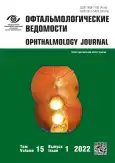A clinical case of the development of choroidal neovascularization in a patient with skin melanoma on the background of therapy with MEK and BRAF inhibitors
- 作者: Tkachenko N.V.1, Belekhova S.G.1, Zhukova N.V.2,3, Prokopchuk V.S.1, Chernova N.S.4
-
隶属关系:
- Pavlov First St. Petersburg State Medical University
- Saint Petersburg State University
- City Clinical Oncological Dispensary
- Almazov National Medical Research Centre
- 期: 卷 15, 编号 1 (2022)
- 页面: 77-85
- 栏目: Case reports
- URL: https://journals.rcsi.science/ov/article/view/107047
- DOI: https://doi.org/10.17816/OV107047
- ID: 107047
如何引用文章
详细
The emergence of targeted therapy has become a significant breakthrough in the management of cancer patients, but even it is not without drawbacks. The article describes a clinical case of the development choroidal neovascularization in a 42-year-old patient with stage IV skin melanoma during 15 months of therapy with MEK and BRAF inhibitors. Clinicians need to remember that such patients may have not only MEK-associated retinopathy, but also other pathological changes in the retina, in particular choroidal neovascularization, which may be associated with both the chemotherapy they receive and the paraneoplastic syndrome itself against the background of the course of the underlying disease. Timely diagnosis and adequate management tactics allow such patients to preserve visual functions.
作者简介
Natalia Tkachenko
Pavlov First St. Petersburg State Medical University
Email: natalyatkachenko@yandex.ru
SPIN 代码: 5187-3670
Cand. Sci. (Med.)
俄罗斯联邦, Saint PetersburgSvetlana Belekhova
Pavlov First St. Petersburg State Medical University
编辑信件的主要联系方式.
Email: beleksv@yandex.ru
ORCID iD: 0000-0003-0293-4811
SPIN 代码: 3637-7441
Cand. Sci. (Med.)
俄罗斯联邦, Saint PetersburgNatalia Zhukova
Saint Petersburg State University; City Clinical Oncological Dispensary
Email: drnvz@yandex.ru
ORCID iD: 0000-0002-0619-2205
SPIN 代码: 3480-2098
Cand. Sci. (Med.), Assistant professor, Head of the Chemotherapeutic Department
俄罗斯联邦, Saint Petersburg; Saint PetersburgVera Prokopchuk
Pavlov First St. Petersburg State Medical University
Email: prokopchuk.vera98@gmail.com
ORCID iD: 0000-0003-3310-6234
Student
俄罗斯联邦, Saint PetersburgNatalya Chernova
Almazov National Medical Research Centre
Email: demod@list.ru
Ophthalmologist
俄罗斯联邦, Saint Petersburg参考
- Gianni L, Panzini I, Li S, et al. Ocular toxicity during adjuvant chemoendocrine therapy for early breast cancer: results from International Breast Cancer Study Group trials. Cancer. 2006;106(3):505–513. doi: 10.1002/cncr.21651
- Bindiganavile S, Bhat N, Lee AG, et al. Targeted Cancer Therapy and Its Ophthalmic Side Effects: A Review. J Immunother Precis Oncol. 2021;4(1):6–15. doi: 10.36401/JIPO-20-21
- Ho WL, Wong H, Yau T. The ophthalmological complications of targeted agents in cancer therapy: what do we need to know as ophthalmologists? Acta Ophthalmol. 2013;91(7):604–609. doi: 10.1111/j.1755-3768.2012.02518
- Liu СY, Francis JH, Abramson DH. Ocular side effects of systemically administered chemotherapy [Internet]. UpToDate, 2022. Available from: https://www.uptodate.com/contents/ocular-side-effects-of-systemically-administered-chemotherapy/print
- Camidge DR, Bang Y-J, Kwak EL, et al. Activity and safety of crizotinib in patients with ALK-positive non-small-cell lung cancer: updated results from a phase 1 study. Lancet Oncol. 2012;13(10):1011–1019. doi: 10.1016/S1470-2045(12)70344-3
- Saleh M, Bourcier T, Noel G, et al. Bilateral macular ischemia and severe visual loss following trastuzumab therapy. Acta Oncol. 2011;50(3):477–478. doi: 10.3109/0284186X.2011.555781
- De la Cruz-Merino L., Di Guardo L., Grob J.-J., et al. Clinical features of serous retinopathy observed with cobimetinib in patients with BRAF-mutated melanoma treated in the randomized coBRIM study // J Transl Med. 2017. Vol. 15. ID146. doi: 10.1186/s12967-017-1246-0
- Stjepanovic N, Velazquez-Martin JP, Bedard PL. Ocular toxicities of MEK inhibitors and other targeted therapies. Ann Oncol. 2016;27(6):998–1005. doi: 10.1093/annonc/mdw100
- Méndez-Martínez S, Calvo P, Ruiz-Moreno O, et al. Ocular adverse events associated with MEK inhibitors. Retina. 2019;39(8):1435–1450. doi: 10.1097/IAE.0000000000002451
- Urner-Bloch U, Urner M, Jaberg-Bentele N, et al. MEK inhibitor-associated retinopathy (MEKAR) in metastatic melanoma: Long-term ophthalmic effects. Eur J Cancer. 2016;65:130–138. doi: 10.1016/j.ejca.2016.06.018
- Francis JH, Habib LA, Abramson DH, et al. Clinical and Morphologic Characteristics of MEK Inhibitor-Associated Retinopathy: Differences from Central Serous Chorioretinopathy. Ophthalmology. 2017;124(12):1788–1798. doi: 10.1016/j.ophtha.2017.05.038
- De la Cruz-Merino L, Di Guardo L, Grob JJ, et al. Clinical features of serous retinopathy observed with cobimetinib in patients with BRAF-mutated melanoma treated in the randomized coBRIM study. J Transl Med. 2017;15:146. doi: 10.1186/s12967-017-1246-0
- Tyagi P, Santiago C. New features in MEK retinopathy. BMC Ophthalmol. 2018;18:221. doi: 10.1186/s12886-018-0861-8
- Albertini GC, Corbelli E, Battaglia Parodi M, Bandello F. Choroidal Neovascularization in Multifocal Choroiditis after Dabrafenib and Trametinib. Eur J Ophthalmol. 2017;27(6):e184–e186. doi: 10.5301/ejo.5001013
- Modjtahedi BS, Maibach H, Park S. Multifocal bilateral choroidal neovascularization in a patient on ipilimumab for metastatic melanoma. Cutan Ocul Toxicol. 2013;32(4):341–343. doi: 10.3109/15569527.2013.781618
- Al-Tweigeri T, Nabholtz J-M, Mackey JR. Ocular toxicity and cancer chemotherapy. A review. Cancer. 1996;78(7):1359–1373. doi: 10.1002/(SICI)1097-0142(19961001)78:7<1359:: AID-CNCR1>3.0.CO;2-G
- Velez-Montoya R, Olson JL, Petrash MJ, et al. Acute Onset Central Serous Retinopathy In Association With Mek Inhibitor Use For Metastatic Cancer. Invest Ophthal Vis Sci. 2011;52:2153–2153.
补充文件












